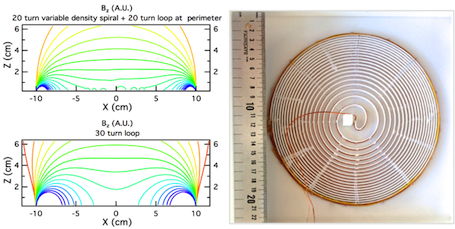A Single Channel Variable Density Spiral Coil for High Sensitivity MRI at 6.5 mT
- 1. University of Western Australia, School of Mechanical & Chemical Engineering, Crawley, Australia
- 2. Harvard University, Department of Physics, Cambridge, United States
Surface coils are a well-established technology for signal enhancement in conventional high field MRI instruments. Specifically designed for localized body regions, surface coils provide high magnetic sensitivity close to the sample resulting in high signal to noise ratios (SNR). However their poor homogeneity generally makes them unsuitable for RF excitation [1]. Their sensitivity can be extended to larger areas when combined in multiple channel arrays, but only for tissues adjacent to the coil, and at the price of advanced decoupling strategies. The present work demonstrates the design of a homogeneous single channel surface coil for both transmit and receive operations at very low magnetic field.
A novel variable-density spiral (VDS) design was implemented to improve B1 signal amplitude and homogeneity. Modeled using BiotSavart 4.0, the variable-density spiral was designed to maintain a constant area between each successive turn. The spiral features 20 turns combined in series with a 20-turn loop around the perimeter to balance the field near the circumference. As shown in fig. 1, compared to a 30-turn, 20 cm diameter loop the VDS design shows flat magnetic field lines in the 2 cm region above the surface and significantly reduced Bz deviation at ± 7.5 cm along the X axis.

The VDS coil was tested in vivo in a human hand using the intrinsic 1H NMR signal and a balanced steady state free precession (b-SSFP) sequence [1]. A custom built, very low-field MRI scanner with a bi-planar 6.5 mT electromagnet (B0) and bi-planar gradients was used for all experiments [2]. The 3D imaging experiment was performed with Cartesian acquisition of k-space and 50% undersampling rate following a Gaussian probability density function [3]. As shown in fig. 2, we achieve (3 × 3 × 6) mm3 voxel size in a 64 × 64 × 7 matrix in 20 minutes, with a maximum SNR of 22. Our design is extremely simple and shows comparable results to multi-channel SQUID detected ultra-low field MRI with improvements in speed, SNR and voxel size [4] [5].

- [1] Scheffler, K., Lehnhardt, S., (2003), Principles and applications of balanced SSFP techniques, Eur. Radiol. 13(11), 2409-18
- [2] Tsai, LL., et al., (2008), An open-access, very-low-field MRI system for posture-dependent 3He human lung imaging, JMR 193, 174-85
- [3] Sarracanie, M., et al., (2014), High Speed 3D Overhauser-Enhanced MRI Using Combined b-SSFP and Compressed Sensing, Mag. Res. Med. 71, 735-45
- [4] Espy, M., et al., (2013), SQUID-detected ultra-low field MRI, J. Mag. Res. 228, 1-15
- [5] Zotev, V., et al., (2008), Parallel MRI at microtesla fields, J. Mag. Res. 192, 197-208
